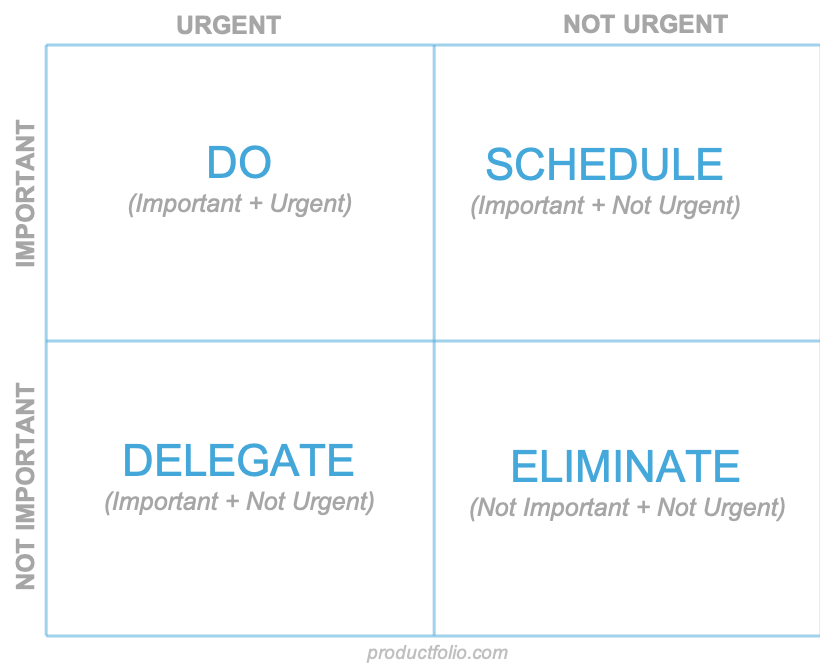While entrepreneurship affords you flexibility, the ability to do something you love, and many more amazing benefits, the work of a business owner never stops. In fact, 81% of business owners routinely work more than a 40-hour week.
As rewarding and lucrative as entrepreneurship can be, there are challenges to overcome. One common issue is deciding which of the thousand tasks on your to-do list should occupy your immediate attention. This can disrupt your work-life balance and lead to burnout. Fortunately, there is a tool to help business owners make the right decisions quickly.
Here’s how you can use the Eisenhower Matrix for business decision-making.
What is the Eisenhower Matrix?
The Eisenhower Matrix is a task-management tool named after Dwight D. Eisenhower, the 34th President of the United States. While he was serving as a General for the U.S. Army during WWII, and surely during his presidential term, Eisenhower was faced with many difficult decisions to make. That’s why he developed a system for categorizing his decisions and tasks based on two criteria: urgency and importance.
Based on the placement of your tasks and decisions, the system offers a simple, straightforward solution to what to tackle next. Let’s explore how you can use the Eisenhower Matrix for business decision-making.
How to Use the Eisenhower Matrix?
When you’re overwhelmed by all the business tasks you have on your plate, the first step to prioritizing is to write a list. Write down everything you’d like to accomplish in your business, whether you consider the task or decision a priority.
Once you’ve created a to-do list, all you need to do is categorize each item into one of the four quadrants within the Eisenhower Matrix diagram and follow the actionable steps designated for each category. Let’s learn more about the four quadrants and how to use them.
The Four Quadrants of the Eisenhower Matrix

Image Source: https://productfolio.com/eisenhower-matrix/
The Eisenhower Matrix is represented by a diagram divided into four squares. Each square has a specific instruction attached to it, which will help you get rid of the confusion and ruminating that causes analysis paralysis. As a result, you will save valuable time.
Before you start categorizing, get to know what each quadrant of the Eisenhower Matrix means by reading below.
Do
Look at your to-do list and identify the tasks and decisions tied to rigid deadlines. These tasks are both important and urgent, and they demand your immediate attention.
Failing to prioritize these tasks or make these decisions within a specific time frame will result in negative consequences. So, write these down in the top-left quadrant labeled ‘do’ and get cracking!
Schedule
The top-right quadrant labeled ‘schedule’ is for important but not urgent tasks. You know that completing these tasks will help you reach your long-term business goals, but because of your busy day-to-day schedule, you just haven’t managed to get around them yet.
Simply choose a designated time to complete this task and commit to this appointment you’ve set for yourself. Treat it like a routine dental appointment if you need to. This way, you can complete the duties that will propel your business forward without them weighing you down and causing mental clutter.
Delegate
The bottom-left quadrant labeled ‘delegate’ represents tasks that are urgent but not necessarily important. As a business owner, you may find it difficult to get help from others. It makes sense.
Your business is like a baby you’ve been nurturing for years, and you may feel you’re the only one equipped to manage it correctly. That being said, knowing when to ask for help is an extremely valuable skill. It allows you to free up time and build a team of people you can trust to act in the best interest of your business.
Using the Eisenhower Matrix for business decision-making is a great way to practice if you have some ‘control freak’ tendencies.
Eliminate
Your ability to identify time-wasters and trivial matters as a business owner is crucial as it will save you lots of time and energy. The bottom-right quadrant is labeled ‘eliminate’ for tasks and decisions that are neither important nor urgent.
It will be a relief for you to get rid of these unnecessary tasks, and you’ll feel free to pursue more important items on your list or finally close your laptop and do something fun.
Sign up for 12 new, free courses on topics from SBA loans to influencer marketing. Verizon Small Business Digital Ready.
Tips for Prioritization
While using the Eisenhower Matrix for business decision-making, you may still encounter setbacks. Be patient with yourself. Giving in to distractions and getting behind on work every now and then is normal.
These three tips might help you stay on track as you learn to better prioritize your tasks and decisions.
1. Eliminate Tasks First
You may naturally want to focus on what needs to be done first. However, eliminating distractions and unnecessary tasks can help you cut down your to-do list.
This can help you free up your time for the most important tasks and get rid of the mental clutter that causes procrastination.
2. Focus on One Task at a Time
According to a study by the Cleveland Clinic, the human brain cannot effectively juggle more than one task at a time. Instead, what most of us consider multitasking is actually the act of quickly alternating between tasks. So, as you attack the duties and decisions in the ‘do’ quadrant of your diagram, focus on one at a time.
3. Limit Your To-Do List to Ten Items
During the first step to using the Eisenhower Matrix for business decision-making, try to keep your to-do list to a maximum of 10 items. Use the first tip (listed above) of eliminating tasks to cut down your list.
Try to ask yourself a few questions before writing a task on your to-do list. How important is this task to the success of your business? Why is it important? Does it align with your business goals? The answers to those questions will not only help you to prioritize your tasks but might also help you do some refocusing to ensure you’re on the right path.
Eisenhower Matrix Examples
There are hundreds of ways you can use the Eisenhower Matrix for business decision-making, but here are a couple you can surely relate to as a modern business owner.
Business goal-setting is crucial to your growth, but some goals are more urgent and important than others. You can use the Eisenhower Matrix to decide which goals to focus on now versus scheduling them for a later date, delegating them, or deleting them altogether. For example, your time-sensitive client work is an important, urgent task that would likely go in the ‘do’ quadrant. On the other hand, perhaps you aim to improve your online presence. This is important for any business seeking to expand, but it’s not time-sensitive, so you can schedule it for another time.
Urgent but unimportant tasks pop up all the time. For example, answering a simple email is a task you could delegate to a member of your team. Do you really need to schedule that extra weekly meeting? Perhaps you and your team could use the time you usually use staring at one another awkwardly over Zoom more productively by attacking tasks in your ‘do’ quadrant.
Other common examples include using the Eisenhower Matrix for time management, planning client work, marketing, and financial management.
Summary
The Eisenhower Matrix is a task-management tool to prioritize the many duties and decisions associated with entrepreneurship. Using the Eisenhower Matrix for business decision-making involves writing a to-do list and categorizing each item on your list within the four quadrants depending on their importance and urgency. The four quadrants are:
- Do
- Schedule
- Delegate
- Eliminate
Keeping your to-do list at a maximum of 10 items, focusing on one task at a time, and eliminating your tasks before prioritizing are great ways to stay on track. You can also use the Eisenhower matrix to manage various business tasks, including goal setting, time management, client work, marketing, and financial management.






